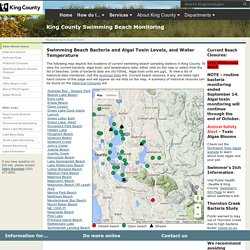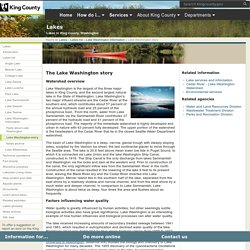

Mercer Island and Lake Washington Water Quality. Mercer Island & Lake Washington Water Quality The City of Mercer Island, in partnership with King County, has been studying how our community's storm water runoff affects water quality in Lake Washington since 1999.

In that time, we have learned a lot. Most importantly, Mercer Island is a relatively good steward of the Lake's water quality when measured against water quality standards used by the state and other agencies: We are complying with basic state and federal standards for ammonia-nitrogen concentrations, temperature (except during July and August), and pH (water samples are neither too acidic nor too alkaline). Over the course of this eleven year project, only one herbicide or pesticide has been detected at concentrations above available guidelines, and that was diazinon from a sample collected from Basin 32 in 2001. But this doesn't mean we can't do better: To read the final version of the 2008-2010 report, please click here. Toxic Loadings Reaching Lake Washington.
Project location: Lake Washington Watershed, King County, Washington Project period: September 2010 through March, 2014 U.S.

EPA grant amount: $698,646 ProblemFish containing polychlorinated biphenyls (PCBs) can pose a health risk to people who consume them. Lake Washington, the largest freshwater lake in King County, Washington, has fish with some of the highest concentrations of polychlorinated biphenyls (PCBs) measured across the state. PCBs were historically used in commercial products and industry but their manufacture was banned in 1977.
No one knows exactly where PCBs in Lake Washington fishes originate. What input pathways contribute PCBs to Lake Washington? Please refer to the EPA's PCB website (external link) for background information on PCBs. Project objectives This project will develop quantitative tools to inform water quality managers of the major PCB and polybrominated diphenyl ether (PBDE) pathways to the Lake Washington watershed and Elliott Bay. Project Status: Swimming Beach Bacteria and Algal Toxin Levels. NOTE - routine bacteria monitoring ended September 14.

Algal toxin monitoring will continue through the end of October. Animal Safety Alert - Toxic Algae Blooms Check out the Northwest Toxic Algae website to learn about toxic algae and your pet. Swimmer's Itch Information Visit Public Health -Seattle & King County Swimmer's Itch Page to learn about swimmer's itch. Thornton Creek Bacteria Study Public warned to stay out of Thornton Creek due to high bacteria levels; based on an intensive study done by the City of Seattle. We recommend avoiding contact with water from the following creeks due to high bacteria levels: John's Creek, Juanita Creek, Ravenna Creek, Idylwood Creek, and Thornton Creek.
Real Time Water Quality Profile Data for Lake Washington. Quick Facts On Lake Washington. Water quality On the whole, the water quality of Lake Washington is extraordinary for a large lake surrounded by urban development--perhaps the best in the world.

Key factors for the lake's excellent water quality include: The cleanliness of the Cedar River, which provides half of its inflow; A rapid flushing rate, with average water residence only 2.3 years; The lake's depth, which causes waters in the lake to mix from top to bottom annually, oxygenating the lowest waters (which prevents the chemical release of phosphorus from the lake floor).
There are, however, water quality concerns in the lake, including: A long-term trend of increasing alkilinity, the causes and effects of which are unclear; Spring algal blooms in 1995 and 1996 that were the worst in more than a decade; High fecal coliform counts in some localized areas. Fish habitat. The Lake Washington Story. Watershed overview Lake Washington is the largest of the three major lakes in King County, and the second largest natural lake in the State of Washington.

Lake Washington's two major influent streams are the Cedar River at the southern end, which contributes about 57 percent of the annual hydraulic load and 25 percent of the phosphorus load,. From the north, water from Lake Sammamish via the Sammamish River contributes 27 percent of the hydraulic load and 41 percent of the phosphorus load. The majority of the immediate watershed is highly developed and urban in nature with 63 percent fully developed.
Water Quality Monitoring Report.